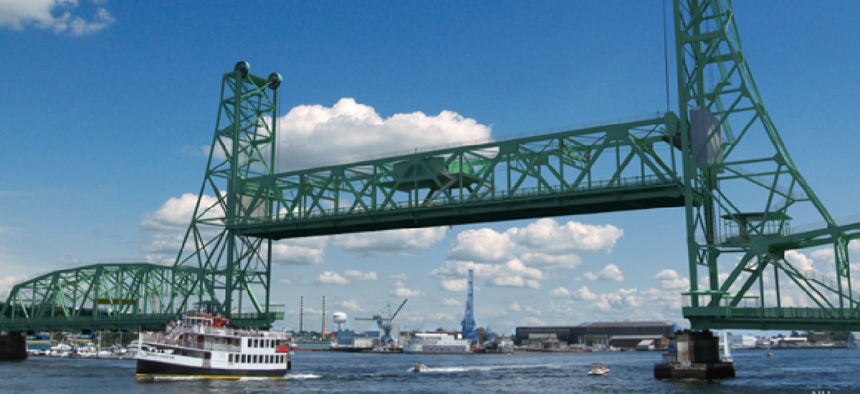‘Living Bridge’ pioneers smart infrastructure

Lights and sensors monitoring the structure and environmental conditions around New Hampshire’s Memorial Bridge are powered by underwater turbines.
According to Erin Bell, the project to transform New Hampshire's Memorial Bridge over the Piscataqua River into a self-diagnosing, self-reporting “smart bridge” resulted from a fortuitous sequence of events.
Bell, an associate professor of civil and environmental engineering at the University of New Hampshire, said a colleague in the School of Marine Science and Ocean Engineering came to her in 2013 with the idea of conducting a three-month test using the bridge before it was torn down to make way for a new structure. The plan was to attach an underwater turbine to the old Memorial Bridge that would generate electricity from the tidal motion of the water in the river.
As she began making inquiries with the state, Bell was surprised when the contractor building the replacement bridge asked whether the turbine could instead be sited on the new vertical-lift bridge for a long-term deployment. “So that’s where the project started,” she said.
One part of Bell’s work involves using sensors for structural monitoring. “We would put sensors on the girders to make sure we are not over stressing [the bridge],” she said. Then it occurred to the team that they could power the sensors with electricity generated by the tidal turbine.
Bell decided to apply for grant from the National Science Foundation’s Partnerships for Innovation program, and that led to further expansion of the project. The program, Bell explained, encourages interdisciplinary research because it requires grant recipients to work with a state agency and with at least two industry partners.
After the team put in a proposal, reviewers said “they wanted us to have more of a social science presence,” Bell said. “So that’s how we added our sociologist who is doing public surveys and looking at how people receive scientific information, how they feel about renewable energy and how they feel about smart infrastructure.”
According to Bell, however, there was a problem. Adding a social scientist meant there wasn’t enough funding to build the turbine and deploy the sensors. Fortunately, she said, the state was willing to step up, and the team was awarded $400,000 by the New Hampshire Department of Transportation to expand the sensor network on the bridge.
Funding in hand, the team is preparing to install a suite of sensors on the bridge, including accelerometers, tilt meters and “strain brevets” that measure pressure. All the sensors are wired to a node that transmits the data via Bluetooth to a hub.
The team is also installing environmental sensors to monitor water quality, including salinity, turbidity and temperature, and an acoustic Doppler current profiler will be used to collect data about water flows.
Finally, the researchers will install a weather station on the bridge to monitor temperature and humidity. That data is important because engineers have found that high winds affect structures like the Memorial Bridge differently depending on the temperature and humidity.
“There are a lot of things we will learn about the future of bridge design,” Bell said. And what the team learns may also help bridge managers make better decisions about maintenance and daily operations, such as raising a span to let shipping traffic sail underneath. With the data, she said, bridge operators will know “when they shouldn’t lift rather than just saying, ‘I think it’s too windy so were not going to do a lift today.’”
The three-meter-wide tidal turbine will power not only the sensors but also the bridge lighting. The idea, Bell said, is to make the infrastructure independent of the electricity grid. That idea was spawned from Hurricane Sandy, when there was no fuel or electricity, she said. “How would we lift this bridge if that happened here?”
While the single turbine doesn’t generate enough power to lift the span on the Memorial Bridge, this project is only a demonstration of the concept. “When new bridges are built perhaps a larger array of these turbines can be integrated so the bridge will no longer be grid dependent,” she said.
Bell sees the Living Bridge project as part of a paradigm shift in her field toward integrating technologies and disciplines to make infrastructure smarter. “The idea was to make the bridge a living laboratory, something that students from kindergarten to PhD candidates could learn from."





